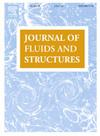Experimental investigation of torsional effects on cross-flow oscillations in flow-induced vibrations of a triangular prism
IF 3.5
2区 工程技术
Q1 ENGINEERING, MECHANICAL
引用次数: 0
Abstract
This study experimentally investigates the flow-induced vibration (FIV) response of a rigid equilateral triangular prism with one and two degrees of freedom (DoF). The primary focus is on assessing how introducing rotational oscillations (a second DoF) influences cross-flow (CF) oscillations (the first DoF) through a series of water tunnel experiments. The system’s dynamic response is characterized at five initial angles of attack (), within a Reynolds number range of 525 to 3,817. For the one-DoF configuration in the CF direction, a galloping-type instability is observed at and . However, when torsional motion is introduced as a second DoF, the onset of oscillations is delayed, and the amplitude of CF oscillations is significantly reduced. This suppression is attributed to changes in the mean angle of attack and the influence of periodic rotational oscillations. The periodic prism rotation modifies the flow-afterbody interaction, leading to weakened flow forces in the CF direction and further reducing the vibration amplitude. Particle Image Velocimetry (PIV) measurements reveal notable differences in the wake structures between the one- and two-DoF cases. In the two-DoF configuration, the prism’s rotation shifts the separation points, leading to asymmetric vortex shedding between the upper and lower sides. This asymmetry periodically modulates the wake dynamics and sustains the rotational oscillations of the prism.
三角棱镜流激振动中扭转效应对横流振荡的实验研究
实验研究了一自由度和二自由度刚性等边三角棱镜的流激振动响应。主要重点是通过一系列水洞实验来评估引入旋转振荡(第二自由度)对横流振荡(第一自由度)的影响。系统的动态响应在5个初始攻角(α=0°,15°,30°,45°,60°)下,雷诺数范围为525至3817。对于CF方向的单自由度构型,在α=45°和60°处观察到驰动型不稳定性。然而,当扭转运动作为第二自由度引入时,振荡的开始被延迟,并且CF振荡的幅度显着降低。这种抑制归因于平均攻角的变化和周期性旋转振荡的影响。周期性的棱镜旋转改变了流-后体相互作用,导致CF方向的流动力减弱,进一步降低了振动幅值。粒子图像测速(PIV)测量揭示了尾迹结构在单自由度和双自由度情况下的显著差异。在双自由度结构中,棱镜的旋转使分离点移位,导致上下两侧不对称的旋涡脱落。这种不对称性周期性地调节了尾流动力学,并维持了棱镜的旋转振荡。
本文章由计算机程序翻译,如有差异,请以英文原文为准。
求助全文
约1分钟内获得全文
求助全文
来源期刊

Journal of Fluids and Structures
工程技术-工程:机械
CiteScore
6.90
自引率
8.30%
发文量
173
审稿时长
65 days
期刊介绍:
The Journal of Fluids and Structures serves as a focal point and a forum for the exchange of ideas, for the many kinds of specialists and practitioners concerned with fluid–structure interactions and the dynamics of systems related thereto, in any field. One of its aims is to foster the cross–fertilization of ideas, methods and techniques in the various disciplines involved.
The journal publishes papers that present original and significant contributions on all aspects of the mechanical interactions between fluids and solids, regardless of scale.
 求助内容:
求助内容: 应助结果提醒方式:
应助结果提醒方式:


